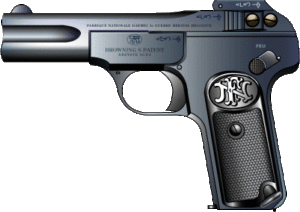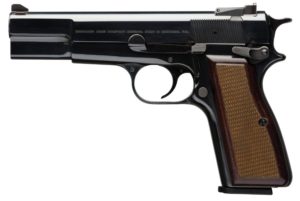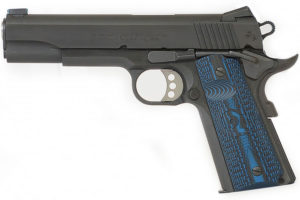I am a big John Moses Browning fan, even if I do own more GLOCKs than most people. J I have several of his pistols from the turn of the century. At a time when most of the world was using revolvers, Browning introduced the first semi-automatic pistol to use a slide! His 1896 design was produced by Fabrique National (FN) as the M1900. I have one in my collection manufactured in 1909. It doesn’t look nearly as good as this photo though.

In 1905, Browning’s M1905 was introduced by FN. It’s a delightfully tiny pistol that has a teeny weenie grip safety. This model is virtually identical to Colt’s M1908 Vest Pocket, the only time Browning’s design was unmodified by both Colt and FN. This little fella was the very first pistol manufactured with a grip safety. The grip safety was added to its big brother a few years later, the Colt 1911.

Here’s a bit of cool history. About 10 years after the United States adopted Browning’s design for the US military’s Colt 1911, the French military requested a new gun from FN. They were looking for a grande rendement (high yield) pistol in 9mm. The original M1911 only held 7 rounds of .45ACP. The French wanted more. John Browning went to FN’s plant in Belgium to work with his disciple, Dieudonné Joseph Saive and build a new pistol. Unfortunately, he had sold the patent rights of the M1911 to Colt, so they had to start from scratch.
They finished their design of a locked breech pistol and requested a patent in 1923. The patent was granted in 1927, four months after John Moses Browning had died. The FN Browning Grande Rendement had a 13+1 capacity, fully double the Colt 1911. After the M1911 patent expired, Saive redesigned the Grande Rendement to incorporate the best of both pistols. In 1935, FN produced the Grande Puissance (High Power) model GP35. The FN Browning High Power was the first 9mm with a staggered-column magazine, or what we call today a double-stack. Most of the very concealable (and comfortable) pistols are single-stack. They are skinnier, and therefore easier to hide.
Here in America, John Moses Browning is a gun-designing legend, and his Colt 1911 is one of the finest firearms ever built. Yet only one country adopted the 1911 as its military sidearm. While the French Army did not adopt the Browning Hi Power, over 55 other countries have. In fact, during WW II the Browning Hi Power was being used by both sides of the conflict. I’m not aware of another firearm formally adopted for use by both sides of the conflict.
Below is a pic of my Browning Hi Power Standard with high polish blueing, ambi safety, walnut grips and adjustable sights. It’s a thing of beauty, and a joy to behold.

Most folks don’t realize that if the firearm is marked “Browning Arms Company” as mine is, then it’s a Hi Power. If it’s marked “Fabrique Nationale” then it’s a High Power. Browning made the distinction in the 50’s to avoid confusion with the Browning High-Power Rifle.
The only downside to the venerable Browning Hi Power is the abbreviated beaver tail. Notice the beaver tail on the grip of this Colt 1911 I just purchased in 9mm.

Because the beaver tail is stumpy on the Hi Power, when the gun cycles, the slide cocks the hammer – and pushes the hammer down a little bit further as it returns to battery, and this tends to pinch the shooter’s hand. This is called Hi Power “hammer bite.”
Since I have a Browning Hi Power with Nazi markings dating from early WW II in my collection, I’ve decided to send my new Hi Power off to Robar Guns for some ‘smithing. The plan is to have them…
- Add a new beaver tail and a bobbed hammer, not unlike my 1911 above.
- Do a trigger job to reduce the 9-pound trigger.
- Refinish the pistol from high gloss blueing to something matte or satin
The work will take weeks with their backlog, but I’ll be sure to post a picture when I get it back. In the meantime, I’ll keep shooting the Colt 1911 9mm… and my GLOCK.
Shoot safe, shoot often. See you at the range,
JoeGLOCK
